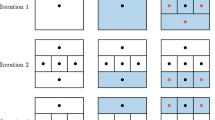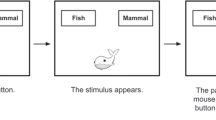Abstract
Two approaches to motor redundancy, optimization and the principle of abundance, seem incompatible. The former predicts a single, optimal solution for each task, while the latter assumes that families of equivalent solutions are used. We explored the two approaches using a four-finger pressing task with the requirement to produce certain combination of total normal force and a linear combination of normal forces that approximated the total moment of force in static conditions. In the first set of trials, many force–moment combinations were used. Principal component (PC) analysis showed that over 90% of finger force variance was accounted for by the first two PCs. The analytical inverse optimization (ANIO) approach was applied to these data resulting in quadratic cost functions with linear terms. Optimal solutions formed a hyperplane (“optimal plane”) in the four-dimensional finger force space. In the second set of trials, only four force–moment combinations were used with multiple repetitions. Finger force variance within each force–moment combination in the second set was analyzed within the uncontrolled manifold (UCM) hypothesis. Most finger force variance was confined to a hyperplane (the UCM) compatible with the required force–moment values. We conclude that there is no absolute optimal behavior, and the ANIO yields the best fit to a family of optimal solutions that differ across trials. The difference in the force-producing capabilities of the fingers and in their moment arms may lead to deviations of the “optimal plane” from the subspace orthogonal to the UCM. We suggest that the ANIO and UCM approaches may be complementary in the analysis of motor variability in redundant systems.







Similar content being viewed by others
References
Ait-Haddou R, Jinha A, Herzog W, Binding P (2004) Analysis of the force-sharing problem using an optimization model. Math Biosci 191:111–122
Bernstein NA (1967) The co-ordination and regulation of movements. Pergamon Press, Oxford
Bottasso CL, Prilutsky BI, Croce A, Imberti E, Sartirana S (2006) A numerical procedure for inferring from experimental data the optimization cost functions using a multibody model of the neuro-musculoskeletal system. Multibody Syst Dyn 16:123–154
Feldman AG (1986) Once more on the equilibrium-point hypothesis (lambda model) for motor control. J Mot Behav 18:17–54
Feldman AG, Levin MF (1995) The origin and use of positional frames of reference in motor control. Behav Brain Sci 18:723–806
Freitas SM, Scholz JP (2009) Does hand dominance affect the use of motor abundance when reaching to uncertain targets? Hum Mov Sci 28:169–190
Gelfand IM, Latash ML (1998) On the problem of adequate language in movement science. Mot Control 2:306–313
Goodman SR, Latash ML (2006) Feed-forward control of a redundant motor system. Biol Cybern 95:271–280
Gorniak SL, Zatsiorsky VM, Latash ML (2007) Hierarchies of synergies: an example of two-hand, multi-finger tasks. Exp Brain Res 179:167–180
Harris CM, Wolpert DM (1998) Signal-dependent noise determines motor planning. Nature 394:780–784
Kaiser HF (1960) The application of electronic computers to factor analysis. Psychol Meas 20:141–151
Krishnamoorthy V, Latash ML, Scholz JP, Zatsiorsky VM (2003) Muscle synergies during shifts of the center of pressure by standing persons. Exp Brain Res 152:281–292
Latash ML (2008) Synergy. Oxford University Press, New York
Latash ML (2010) Motor control: in search of physics of the living systems. J Hum Kinet 24:7–18
Latash ML, Scholz JF, Danion F, Schöner G (2001) Structure of motor variability in marginally redundant multifinger force production tasks. Exp Brain Res 141:153–165
Latash ML, Scholz JP, Schöner G (2002) Motor control strategies revealed in the structure of motor variability. Exerc Sport Sci Rev 30:26–31
Latash ML, Shim JK, Smilga AV, Zatsiorsky VM (2005) A central back-coupling hypothesis on the organization of motor synergies: a physical metaphor and a neural model. Biol Cybern 92:186–191
Latash ML, Scholz JP, Schoner G (2007) Toward a new theory of motor synergies. Mot Control 11:276–308
Latash ML, Friedman J, Kim SW, Feldman AG, Zatsiorsky VM (2010) Prehension synergies and control with referent hand configurations. Exp Brain Res 202:213–229
Li ZM, Latash ML, Zatsiorsky VM (1998) Force sharing among fingers as a model of the redundancy problem. Exp Brain Res 119:276–286
Martin V, Scholz JP, Schöner G (2009) Redundancy, self-motion and motor control. Neural Comput 21:1371–1414
Murray RM, Li Z, Sastry S (1994) A mathematical introduction to robotic manipulation. CRC Press, Roca Baton, FL
Mussa Ivaldi FA, Morasso P, Zaccaria R (1988) Kinematic networks. A distributed model for representing and regularizing motor redundancy. Biol Cybern 60:1–16
Newell KM, Carlton LG (1988) Force variability in isometric responses. J Exp Psychol Hum Percept Perform 14:37–44
Newell KM, Corcos DM (1993) Variability and motor control. Human Kinetics Publishers Champaign, IL
Oldfield RC (1971) The assessment and analysis of handedness: the Edinburgh inventory. Neuropsychologia 9:97–113
Prilutsky BI, Zatsiorsky VM (2002) Optimization-based models of muscle coordination. Exerc Sport Sci Rev 30:32–38
Raikova RT, Prilutsky BI (2001) Sensitivity of predicted muscle forces to parameters of the optimization-based human leg model revealed by analytical and numerical analyses. J Biomech 34:1243–1255
Robert T, Zatsiorsky VM, Latash ML (2008) Multi-muscle synergies in an unusual postural task: quick shear force production. Exp Brain Res 187:237–253
Rosenbaum DA, Meulenbroek RJ, Vaughan J, Jansen C (2001) Posture-based motion planning: applications to grasping. Psychol Rev 108:709–734
Schmidt RA, Zelaznik H, Hawkins B, Frank JS, Quinn JT Jr (1979) Motor-output variability: a theory for the accuracy of rapid motor acts. Psychol Rev 47:415–451
Scholz JP, Schöner G (1999) The uncontrolled manifold concept: identifying control variables for a functional task. Exp Brain Res 126:289–306
Scholz JP, Schöner G, Latash ML (2000) Identifying the control structure of multijoint coordination during pistol shooting. Exp Brain Res 135:382–404
Scholz JP, Danion F, Latash ML, Schöner G (2002) Understanding finger coordination through analysis of the structure of force variability. Biol Cybern 86:29–39
Seif-Naraghi AH, Winters JM (1990) Optimal strategies for scaling goal-directed arm movements. In: Winters JM, Woo SL-Y (eds) Multiple muscle systems: biomechanics and movement organization. Springer, New York, pp 312–334
Siemienski A (2006) Direct solution of the inverse optimization problem of load sharing between muscles. J Biomech 39(Suppl. 1):45
Terekhov AV, Pesin YB, Niu X, Latash ML, Zatsiorsky VM (2010) An analytical approach to the problem of inverse optimization with additive objective functions: an application to human prehension. J Math Biol 61:423–453
Todorov E, Jordan MI (2002) Optimal feedback control as a theory of motor coordination. Nat Neurosci 5:1226–1235
Tsirakos D, Baltzopoulos V, Bartlett R (1997) Inverse optimization: functional and physiological considerations related to the force-sharing problem. Crit Rev Biomed Eng 25:371–407
Whitney DE (1969) Resolved motion rate control of manipulators and human prostheses. IEEE Trans Man Machine Syst 10:47–53
Yang JF, Scholz JP, Latash ML (2007) The role of kinematic redundancy in adaptation of reaching. Exp Brain Res 176:54–69
Zatsiorsky VM, Latash ML (2008) Multifinger prehension: an overview. J Mot Behav 40:446–476
Zatsiorsky VM, Li ZM, Latash ML (1998) Coordinated force production in multi-finger tasks: finger interaction and neural network modeling. Biol Cybern 79:139–150
Zatsiorsky VM, Li ZM, Latash ML (2000) Enslaving effects in multi-finger force production. Exp Brain Res 131:187–195
Acknowledgments
The study was in part supported by NIH grants AG-018751, NS-035032, and AR-048563. We are grateful to Dr. Alexander Terekhov for his help at the early phases of this project.
Author information
Authors and Affiliations
Corresponding author
Appendices
Appendix 1
Uniqueness theorem (for the mathematical proof see Terekhov et al. 2010)
The core of the ANIO approach is the theorem of uniqueness that specifies conditions for unique (with some restrictions) estimation of the objective functions. The main idea of the theorem of uniqueness is to find necessary conditions for the uniqueness of solutions in an inverse optimization problem. An optimization problem (i.e., direct optimization problem) with an additive objective function and linear constraints are defined as:
where \( X = (x_{1} ,x_{2} , \ldots ,x_{n} ) \in R_{n} ,g_{i} \) is an unknown scalar differentiable function with \( g^{\prime } ( \cdot ) > 0.\) g i came from the Lagrange minimum principle, which has a unique solution. On the contrary, the functions of g i can be computed from the set of solutions X* (e.g., experimental data). This inverse procedure is called the inverse optimization problem. C is a k × n matrix and B is a k-dimension vector, k < n.
First, assume that the optimization problem Eq. 14 with k ≥ 2 is non-splittable. If the inverse optimization is splittable, the preliminary step is to split it until a non-splittable subproblem is acquired. If the functions g i (x i ) in problem Eq. 14 are twice continuously differentiable (i.e., twice continuously differentiable functions f i ) and \( f_{i}^{\prime } \) is not identically constant, complying \( \overset{\lower0.5em\hbox{$\smash{\scriptscriptstyle\smile}$}}{C} f^{\prime } (X) = 0 \) for all X ∈ X *,
and
then
for every \( x_{i} \in X_{i}^{*} \), where \( X_{i}^{*} \) = {s| there is X ∈ X *: x i ∈ s} and X * is the set of the solutions for all B ∈ R k. The constants q i satisfy the equation \( \overset{\lower0.5em\hbox{$\smash{\scriptscriptstyle\smile}$}}{C} q = 0 \) where q = (q 1,…,q n )T. Primes designate derivatives.
If the experimental data correspond to solutions of an inverse optimization problem with additive objective function (g i ) and linear constraints, equation \( \overset{\lower0.5em\hbox{$\smash{\scriptscriptstyle\smile}$}}{C} f^{\prime } (X) = 0 \) (X ∈ X *) must be satisfied (i.e., the Lagrange principle). The Uniqueness Theorem provides sufficient condition (i.e., \( \overset{\lower0.5em\hbox{$\smash{\scriptscriptstyle\smile}$}}{C} f^{\prime } (X) = 0 \)) for solving the inverse optimization problem in a unique way up to linear terms.
Appendix 2
Uncontrolled manifold (UCM) analysis (see Latash et al. 2002, 2007 for details)
For F TOT, changes in the elemental variables (finger forces) sum up to produce a change in F TOT:
The UCM was defined as an orthogonal set of the vectors e i in the space of the elemental forces that did not change the net normal force, i.e.:
These directions were found by taking the null-space of the Jacobian of this transformation ([1 1 1 1] e i ). The mean-free forces were then projected onto these directions and summed to produce:
where n = 4 is the number of degrees-of-freedom of the elemental variables, and P = 1 is the number of degrees-of-freedom of the performance variable (F TOT). The component of the de-meaned forces orthogonal to the null-space is given by:
The amount of variance per degree-of-freedom parallel to the UCM is:
The amount of variance per degree-of-freedom orthogonal to the UCM is:
The normalized difference between these variances is quantified by a variable ΔV:
where V TOT is the total variance, also quantified per degree-of-freedom. If ΔV is positive, V UCM > V ORT, caused by negative co-variation of the finger forces, which we interpret as evidence for a force-stabilizing synergy. In contrast, ΔV = 0 indicates independent variation of the finger forces, while ΔV < 0 indicates positive co-variation of the individual finger forces, which contributes to variance of F TOT.
A similar procedure was used to compute the two variance components related to stabilization of M TOT. The only difference was in using a different Jacobian corresponding to the lever arms of individual finger forces, [d i d m d r d l ].
We also analyzed the data with respect to the stabilization of both F TOT and M TOT simultaneously. In that case, the Jacobian was [1 1 1 1 d i d m d r d l ]. The dimensionality of V UCM for the analysis with respect to F TOT and M TOT separately is three (one constraint), while the dimensionality of V UCM with respect to F TOT and M TOT simultaneously is two (two constraints).
Rights and permissions
About this article
Cite this article
Park, J., Zatsiorsky, V.M. & Latash, M.L. Optimality vs. variability: an example of multi-finger redundant tasks. Exp Brain Res 207, 119–132 (2010). https://doi.org/10.1007/s00221-010-2440-y
Received:
Accepted:
Published:
Issue Date:
DOI: https://doi.org/10.1007/s00221-010-2440-y




